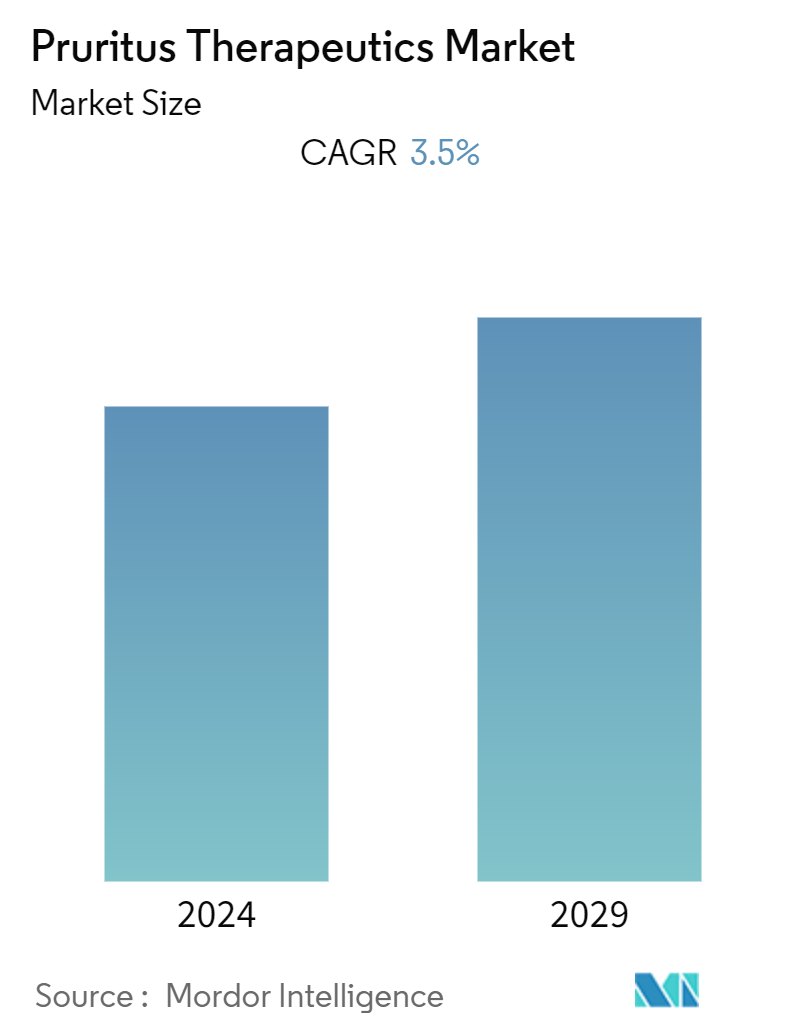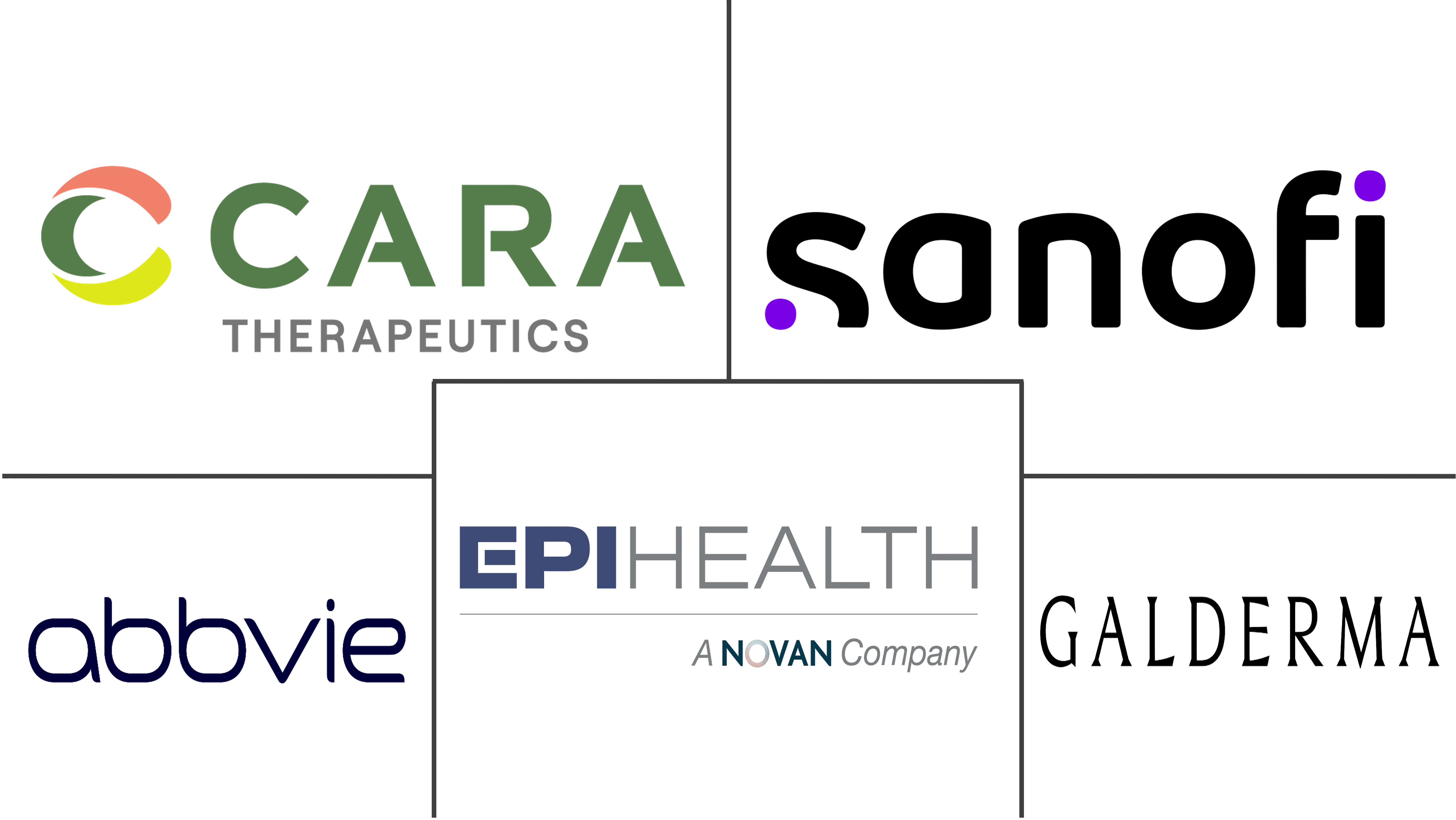Market Size of Pruritus Therapeutics Industry

| Study Period | 2019 - 2029 |
| Base Year For Estimation | 2023 |
| Forecast Data Period | 2024 - 2029 |
| CAGR (2024 - 2029) | 3.50 % |
| Fastest Growing Market | Asia-Pacific |
| Largest Market | North America |
Major Players
*Disclaimer: Major Players sorted in no particular order |
Pruritus Therapeutic Market Analysis
The Pruritus Therapeutics Market is expected to register a CAGR of 3.5% during the forecast period.
The impact of COVID-19 on the studied market was adverse in the initial phases owing to the cancellations of elective procedures, including treatment of pruritus, which impacted the studied market. For instance, as per the IJCED article, COVID-19 posed unique challenges for all healthcare specialists, including dermatologists, while treating skin conditions, including urticaria, a common dermatological condition. However, the market started to gain traction as treatment facilities and research and development activities to develop innovative therapeutics for pruritus by market players resumed worldwide.
The high prevalence of dermatological diseases like atopic dermatitis, urticaria, cutaneous T-cell, psoriasis, and allergic contact dermatitis and the introduction of novel products to treat the diseases are expected to propel the market growth. In addition, the increasing prevalence of dermatological disorders and the presence of high unmet needs are actively affecting the growth of the studied market.
As per the IJCM article, 20% of the Indian population had skin diseases in 2020. Infections and eczema accounted for two-thirds of the skin diseases in the study population. Also, as per the Life (Basel) Journal, the prevalence of atopic dermatitis was 34% from included studies among Swedish children in 2021. Thus, the high burden of atopic dermatitis or eczema is projected to boost the demand for pruritus therapeutics, as pruritus is an after-effect of these skin diseases.
Additionally, advancements in technology, increasing product approvals, partnerships, and acquisitions by key players are helping in the market growth. For instance, in August 2022, Chugai Pharmaceutical Co. Ltd subsidiary Maruho Co. Ltd launched the anti-IL-31 receptor - a humanized monoclonal antibody Mitchga subcutaneous injection of 60 mg syringes used to alleviate the itching brought on by atopic dermatitis. Mitchga was approved by the Ministry of Health, Labour, and Welfare (MHLW) in March 2022 and listed on the national health insurance (NHI) reimbursement price list in May 2022. Such advancements and developments are likely to boost the demand and usage of pruritus therapeutics in the upcoming year.
Therefore, owing to the aforementioned factors, the studied market is anticipated to witness growth over the analysis period. However, the lack of understanding of disease pathophysiology and the availability of advanced alternative treatment options is likely to impede the market growth.
Pruritus Therapeutic Industry Segmentation
As per the scope of the report, pruritus is a condition of the skin accompanied by an unpleasant and irritating itching sensation over the skin that provokes scratching. Some chemical substances, like histamine, prostaglandins, proteases, substance P, and bile salts, may cause it. Sometimes accompanied by crusts, excoriations, hyperpigmentation, lichenification, pyoderma, increased skin creasing, and burnished nail.
The pruritus therapeutics market is expected to grow at a CAGR of 3.5% over the forecast period. The pruritus therapeutics market is segmented by product type (corticosteroid, antihistamine, local anesthetic, counterirritant, immunosuppressant, calcineurin inhibitors, and other product types), disease type (atopic dermatitis/eczema, allergic contact dermatitis, urticaria, cutaneous T-cell, and other disease types) and geography (North America, Europe, Asia-Pacific, Middle East and Africa, and South America). The report offers the value (in USD million) for the above segments.
| By Product Type | |
| Corticosteroid | |
| Antihistamine | |
| Local Anesthetic | |
| Counterirritant | |
| Immunosuppressant | |
| Calcineurin Inhibitors | |
| Other Product Types (Opioid Receptor Antagonists, Antidepressants and Antipruritics) |
| By Disease Type | |
| Atopic Dermatitis/Eczema | |
| Allergic Contact Dermatitis | |
| Urticaria | |
| Cutaneous T-cell | |
| Other Disease Types (Cholestasis, Haematological, Neurological, Oncological, Renal and Drug Induced) |
| Geography | ||||||||
| ||||||||
| ||||||||
| ||||||||
| ||||||||
|
Pruritus Therapeutics Market Size Summary
The pruritus therapeutics market is poised for growth, driven by the increasing prevalence of dermatological conditions such as atopic dermatitis, urticaria, and psoriasis. The market experienced initial setbacks due to the COVID-19 pandemic, which led to the postponement of elective procedures and challenges in treating skin conditions. However, as healthcare facilities resumed operations and research into innovative treatments progressed, the market began to recover. The introduction of novel therapeutics and the high unmet needs in dermatological care are expected to further propel market expansion. Technological advancements, product approvals, and strategic partnerships among key industry players are also contributing to the market's positive trajectory.
North America is anticipated to lead the market, supported by a robust healthcare infrastructure, a high incidence of skin diseases, and a strong presence of industry players. The region's awareness of available technologies and treatments further bolsters its market position. The corticosteroid segment is expected to grow, driven by the rising geriatric population prone to chronic skin conditions and the increasing demand for over-the-counter topical treatments. The market's competitive landscape is characterized by numerous global and regional companies, with key players like AbbVie Inc., Cara Therapeutics, and Sanofi actively participating in clinical trials and product developments. These efforts are expected to enhance the market's competitiveness and drive growth during the forecast period.
Pruritus Therapeutics Market Size - Table of Contents
-
1. MARKET DYNAMICS
-
1.1 Market Overview
-
1.2 Market Drivers
-
1.2.1 Increasing Prevalence of Dermatological Disorders
-
1.2.2 Presence of High Unmet Needs
-
-
1.3 Market Restraints
-
1.3.1 Lack of Understanding of Disease Pathophysiology
-
1.3.2 Availability of Advanced Alternative Treatment Options
-
-
1.4 Porter's Five Force Analysis
-
1.4.1 Threat of New Entrants
-
1.4.2 Bargaining Power of Buyers/Consumers
-
1.4.3 Bargaining Power of Suppliers
-
1.4.4 Threat of Substitute Products
-
1.4.5 Intensity of Competitive Rivalry
-
-
-
2. MARKET SEGMENTATION (Market Size by Value - USD million)
-
2.1 By Product Type
-
2.1.1 Corticosteroid
-
2.1.2 Antihistamine
-
2.1.3 Local Anesthetic
-
2.1.4 Counterirritant
-
2.1.5 Immunosuppressant
-
2.1.6 Calcineurin Inhibitors
-
2.1.7 Other Product Types (Opioid Receptor Antagonists, Antidepressants and Antipruritics)
-
-
2.2 By Disease Type
-
2.2.1 Atopic Dermatitis/Eczema
-
2.2.2 Allergic Contact Dermatitis
-
2.2.3 Urticaria
-
2.2.4 Cutaneous T-cell
-
2.2.5 Other Disease Types (Cholestasis, Haematological, Neurological, Oncological, Renal and Drug Induced)
-
-
2.3 Geography
-
2.3.1 North America
-
2.3.1.1 United States
-
2.3.1.2 Canada
-
2.3.1.3 Mexico
-
-
2.3.2 Europe
-
2.3.2.1 Germany
-
2.3.2.2 United Kingdom
-
2.3.2.3 France
-
2.3.2.4 Italy
-
2.3.2.5 Spain
-
2.3.2.6 Rest of Europe
-
-
2.3.3 Asia-Pacific
-
2.3.3.1 China
-
2.3.3.2 Japan
-
2.3.3.3 India
-
2.3.3.4 Australia
-
2.3.3.5 South Korea
-
2.3.3.6 Rest of Asia-Pacific
-
-
2.3.4 Middle East and Africa
-
2.3.4.1 GCC
-
2.3.4.2 South Africa
-
2.3.4.3 Rest of Middle East and Africa
-
-
2.3.5 South America
-
2.3.5.1 Brazil
-
2.3.5.2 Argentina
-
2.3.5.3 Rest of South America
-
-
-
Pruritus Therapeutics Market Size FAQs
What is the current Pruritus Therapeutics Market size?
The Pruritus Therapeutics Market is projected to register a CAGR of 3.5% during the forecast period (2024-2029)
Who are the key players in Pruritus Therapeutics Market?
Cara Therapeutics, EPI Health, LLC, Gladerma Laboratories, LP., Sanofi SA and AbbVie Inc. are the major companies operating in the Pruritus Therapeutics Market.

